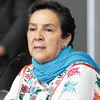Hello Visitor! Log In
Environmental Justice and Equity: An Exploration through the POP Movement
ARTICLE | November 29, 2021 | BY Ash Pachauri, Drishya Pathak, Komal Mittal, Meghana Elsa Thomas, Nahid Pérez Ayala, Norma Patricia Muñoz Sevilla, Philo Magdalene A, Vanessa Anahí Hernández Vázquez
Author(s)
Ash Pachauri
Drishya Pathak
Komal Mittal
Meghana Elsa Thomas
Nahid Pérez Ayala
Norma Patricia Muñoz Sevilla
Philo Magdalene A
Vanessa Anahí Hernández Vázquez
Abstract
Environmental Justice, defined as “The fair treatment and meaningful involvement of all people regardless of race, color, national origin, or income with respect to the development, implementation, and enforcement of environmental laws, regulations, and policies” (EPA), has been the object of study of this article in which it is shown how through the work of Non-Governmental Organizations (NGOs), the problem of inequalities and problems that arise in the day for certain communities and spaces can be revealed. The background shown and the methodology used are the result of numerous activities developed by “The POP Movement” (2016), in collaboration with various organizations, academic institutions, governments, civil society and particularly with young people from various countries around the world, among others: The International Conference and POP Festival for Youth-Led Climate Action; Intergenerational Dialogue on Environmental Justice and Equity; Latin American Dialogue; GlobalMindED Webinar and Truth and Reconciliation Week. The results obtained from the direct participation of the actors are shown through the problem analysis format, which are recorded within the framework of equity, justice, human rights and the environment, during the events. These results have allowed the design of strategies of action to address the identified problem, under the principle of “Youth inspired by Knowledge.” These results are manifested in various areas: Differentiated impact of climate change; Role of government in environmental justice, and Role of communities and other sectors. Finally, the conclusions obtained during the development of the various events mentioned are presented and that lead us to the following consideration, “The threat of the climate crisis is the one that looms over the world. And yet, the impact of climate change disproportionately affects some of the lives and livelihoods of the world’s most vulnerable and marginalized communities.”
1. Introduction
Many areas of climate policy making involve value judgments and ethical considerations. These areas range from the question of how much mitigation is needed to prevent dangerous interference with the climate system, to choices between specific mitigation or adaptation policies.1 Along with the issues of mitigation and adaptation, issues of equity and justice arise.
"The environmental crisis can only be efficiently addressed and solved when each and every one of the deep-rooted social, economic, and political issues around the world is addressed and solved."
In this regard, environmental justice is an idea that is quickly gaining popularity and acceptance in the global movement against the climate crisis. There is a new wave of awareness about the implications of the climate crisis; one that brazenly points out that communities of color, low-income communities, and indigenous communities among other marginalized and vulnerable* populations are disproportionately affected in different ways by the impact of climate change, environmental contamination, and other anthropogenic activities. Environmental justice aims to not only reduce the suffering borne by vulnerable communities owing to the climate crisis, but also to provide these communities with access to environmental resources.
Different countries face disparate challenges and circumstances, and have different capacities to address mitigation and adaptation. Evidence indicates that outcomes that are considered equitable can trigger more effective cooperation (Fifth Report of Intergovernmental Panel on Climate Change).
2. Methodology
The U.S. Environmental Protection Agency (EPA) has defined environmental justice as “The fair treatment and meaningful involvement of all people regardless of race, color, national, origin, or income with respect to the development, implementation, and enforcement of environmental laws, regulations, and policies. Fair treatment means that no group of people, including racial, ethnic, or socioeconomic groups should bear a disproportionate share of the negative environmental consequences resulting from industrial, municipal, and commercial operations or the execution of federal, state, local, and tribal programs and policies.”2The three fundamental pillars or bases of environmental justice are the citizens’ right to justice, citizens’ participation and the right to truthful and effective information, as well as transparency.3
The origin of the ideal of environmental justice, particularly referring to geographic science, although it has a distant history, can particularly be traced back to the last quarter of the 20th century. From then on, expressions of equality, justice and spatial or territorial equity are derived.4 The concept of territorial justice has a lot in common with that of environmental justice,5 since both share a similar approach; to value the distribution of benefits and damages generated by human agents—largely considered as externalities between places and population groups, in order to determine if there is serious discrimination or not. The expression of environmental justice emerged in the 1970s under the protection of movements such as the unequal and racially discriminatory spatial distribution of hazardous waste and polluting industries in the United States, at the same time that the EPA was born, clearly responding to issues of environmental justice. Since then, the idea of environmental justice has spread across the world. The contemporary prevalence of the idea can be attributed to the rising awareness that the environmental crisis can only be efficiently addressed and solved when each and every one of the deep-rooted social, economic, and political issues around the world is addressed and solved.6
The POP (Protect Our Planet) Movement aims to empower youth to have active participation in addressing issues of climate change through knowledge sharing, capacity building, and climate action. With the belief that climate change will disproportionately affect the most vulnerable communities, the POP Movement conceptualizes, plans and executes various interactive activities where different communities and sectors are encouraged to come together, discuss needs and raise awareness on the challenges of and solutions to climate change. To this extent, the POP Movement works closely with different sectors and communities and organizes various capacity building workshops, international knowledge sharing events, mentorship programs and provides platforms for representatives from indigenous communities, media, academia, the legislative, the government, NGOs, and most importantly, youth to promote cross-sectoral and action-oriented engagement to tackle the threats of climate change and environmental degradation, and to amplify and address pertinent issues related to environmental justice. A number of preparatory meetings are conducted with all the concerned stakeholders prior to most events to understand the most pressing environmental problems, and the challenges and opportunities around addressing them, from the perspective of different sectors, from the perspectives of the communities in question. This is central to participatory approaches that facilitate interventions led by and for communities.
This article will showcase and discuss the voices and narratives of different communities and stakeholders collected through a diverse series of interpersonal discussions, events, and dialogue facilitated by the POP Movement. It highlights the importance of meaningfully engaging communities and building their leadership and participation in initiatives intended for them. Content and narratives regarding environmental justice were collected from a plethora of activities and events organized by the POP Movement, such as its flagship annual event called the POP Festival, Intergenerational Dialogue on Environmental Justice and Equity, Latin American Dialogue, GlobalMindED webinar, Conversations with Sidewalk School and Climate Refugees, and the Truth and Reconciliation Week (TRW). These initiatives were designed and conducted in close partnership with the POP Movement’s invaluable collaborators. To showcase the diverse context of these events, they have been briefly discussed below.
2.1. The International Conference and POP Festival for Youth-Led Climate Action
An inclusive global platform building a movement of youth leading innovation, advocacy and change
The annual POP Festival, organized in partnership with over 90 partners, provides a platform to stakeholders and the youth to come together to share their innovative ideas and local, practical solutions to address the threats of climate change and its impacts. The event sees participation of individuals between the ages 5 and 85 from regions including the United States, Mexico and Latin America and the Caribbean (LAC); Africa and the Middle East; and others.
In a segment in POP Festival 2021, leaders from the African region echoed the climate crisis reality in the region, during a session on climate crisis. Through this session, the youth from the various African countries actively participated in the discussion that emphasized issues related to an unsustainable environment such as floods, droughts, and low income, which are prevalent in the region. The discussion was initiated to better understand the cause and effect, scale of impact, and the mitigation process that could bring about the change.
The POP Festival 2021 also facilitated a conversation with Sidewalk School and Climate Refugees, organizations that work to promote the rights and to look at the populations which are displaced both internally and cross-borders as a result of climate change. The session sought to educate people on the situations faced by asylum-seekers at the US southern border and discuss the climate conditions they mention that they are fleeing.
In addition to this, during a session with some of the indigenous groups of Latin America, the topic of agrochemicals and indigenous health and mental health was discussed. This session discussed the problems and impact of the advance of the agricultural patch and extraction activities in indigenous territories on the health of indigenous communities in general, especially on mental health. Yet another session titled Native American Youth Climate Leaders discussed the detrimental environmental effects of the industrialization of territories, and its impact on indigenous communities.
2.2. Intergenerational Dialogue on Environmental Justice and Equity
A platform underscoring the importance of Equity and Justice for Climate Action and Sustainable Development
The event was organized in partnership with the Permanent Secretariat of the World Summit of Nobel Peace Laureates as part of their Youth Program, “Leading by Example”. Through an intergenerational conversation between a global leader and youth from various regions such as Latin America, Africa and Asia, the cause of climate justice, gender equality, inclusion, and resilience was discussed. The dialogue underscored the importance of environmental justice, where equity and justice serve as the fundamental premise for climate action and sustainable development. The session also emphasized the role of leadership, both at the community-level and at higher decision-making level, in promoting inclusive strategies and solutions that uphold the principles of environmental justice.
2.3. Latin American Dialogue
A platform to develop regional youth leadership and promote cross-sectoral engagement
The Second Latin American Dialogue, held in partnership with Dr. Rosalía Arteaga Serrano, on July 2020, served as a platform for representatives from indigenous communities, media, academia, the legislative, the government, NGOs, and most importantly, representatives from among the youth to promote cross-sectoral and action-oriented engagement against the threats of climate change and environmental degradation in the Latin American region. In the buildup to the event, an interactive session was held earlier the same month as a preparatory meeting for stakeholders to understand the most pressing environmental problems in Latin America, and the challenges and opportunities around addressing them, from the perspective of different sectors.
2.4. GlobalMindED Webinar
Strategies for Inclusive, Just, and Equitable Climate Leadership
GlobalMindED closes the equity gap by creating a capable, diverse talent pipeline through connections to role models, mentors, internships for low-income students, and returning adults, First Gen to college and inclusive leaders who teach them, work with them and hire them. The youth panel titled Youth Panel: Strategies for Inclusive, Just, and Equitable Climate Leadership aimed to provide a platform to young people to enable them to amplify their voices by sharing personal experiences about inclusive, just and equitable climate leadership, covering different regions of the world such as North America, Latin America and Africa.
Youth leaders shared their experiences on the manner in which certain climate action interventions practised by them were bringing about a positive change in society. These small-scale interventions are turning out to be a step toward bridging the gap in achieving climate equity and implementing climate culture. Global movements led by youth groups, introduction of educational tools at primary and secondary schools, participation of young people from vulnerable and marginalized populations, and acknowledging the knowledge shared by indigenous communities were some of the tools that the youth advocated for.
2.5. Truth and Reconciliation Week (TRW)
Indigenous Communities on Environmental Degradation and Adaptation
The relationship between indigenous peoples and their environment has been eroded due to continuous environmental damage. The panel to discuss environment-based degradation and adaptation with the indigenous communities, organized as part of TRW, sought to understand how environmental damage has been substantial, and has been impacting their communities. The session also focussed on possible adaptation measures that the community could take at the local level, apart from their dependence on other stakeholders. Lastly, it aimed to promote discussion among the indigenous community and the young people.
3. Results and Analysis
The conversations, dialogues, and discussions that were facilitated during these events served as a means to shed light on crucial issues and solutions with regard to the climate crisis from the perspective of communities themselves. The personal narratives of representatives from among various stakeholders, as well as those of indigenous communities from Latin America and Africa, helped emphasize an irrefutable fact; the impacts of climate change were heavily borne by the most marginalized communities. The discussions also revealed the manner in which governments, communities, and stakeholders could participate in the process of ensuring environmental justice by mitigating the impact of climate change on the most vulnerable and marginalized communities.
3.1. Differentiated Impact of Climate Change
The true extent of the differentiated and disproportionately severe impacts of climate change and anthropogenic activities unfolds itself before the world. One such testament is the case of Timor-Leste, a small developing island state located in Southeast Asia. José Ramos-Horta, the former president of East Timor, noted that Timor-Leste contributes negligible amount of carbon emissions; yet, the island state has faced the repercussions of climate change, and the damage done to the environment. Ironically, while facing the damage that climate change causes, Timor-Leste is yet to benefit from the very same industrialization and extraordinary growth that has brought about the rampant environmental crisis. He also observed that the casualties of the effects of climate change have primarily been the poor, who have very little responsibility for climate change, for environmental pollution and for carbon emissions. He further pointed out that “We must focus on climate change justice, because there has been too much inequity in the receiving end of suffering consequences of climate change.”
The impact of climate change and anthropogenic activities also disproportionately affects indigenous communities in Africa and Latin America. African leaders reflected about the various human-enabled results of human activities and shared their sentiments about the manner in which these climate calamities are impacting Africa, and other countries, in a similar manner.
Natural calamities such as floods and their long-term effects impact various factors such as health, food security, sources of income, social protection, job security and well-being of communities, creating fragile conditions for the citizens, ultimately forcing them to migrate. The impact of climate change has also affected Africa’s agriculture industry, which is the main source of employment in the region. The effects of climate change on the industry are making communities dependent on agriculture vulnerable and impacting their source of income. This leads to the creation of an income gap not only within the communities, but one that also broods nationwide. The impact of climate change on the agriculture industry also affects food security, which is a complex, inter and multisectoral, interinstitutional, inter- and transdisciplinary system, with profound social, economic and environmental implications, with strong synergies at different levels, and can determine the viability for poor or less developed countries or nations.
"People who are fleeing their countries due to climate change
are not covered under international law; they are not eligible for asylum. This is a gap in international law that must be addressed." – Amali Tower
In Latin American countries such as Brazil, the situation is similar; extensive agriculture has resulted in the consumption of high levels of agrochemicals that ultimately affect human and animal health. On the other hand, Mr. Luis Betancourt, Researcher of Indigenous and Environmental Rights in the Venezuelan Amazon, brought to attention the activity of mining, stating that contamination due to mining has caused a number of different diseases among indigenous community members of the region.
Sam Schimmel, Indigenous Youth Advocate and Arctic Youth Ambassador of the Arctic Youth Network, also shed light on some more of the consequences faced by indigenous communities; he spoke of the changes in weather patterns that have changed the migration routes of the animals that indigenous communities rely on for food. Schimmel also drew attention to the detrimental effects of the climate crisis on the mental health of community members, and spoke of the trauma associated with watching places where he and his ancestors had grown up, changing in ways that make these places uninhabitable.
3.2. Role of Government in Environmental Justice
A key part of the discussions that were facilitated were people’s narratives about what it is that can be done by governments in the process to attain environmental justice. Meshack Muga, the National Project Coordinator of The Restoration Initiative Project (GEF project 6) of The Food and Agriculture Organization (FAO) of the United Nations in Kenya, shared information about the restoration of arid and semi-arid areas in the country. Muga noted that Kenya’s local county governments and national government were participants in intervention measures to aid the process of land restoration. The local government agencies included the Kenya Forest Service, Kenya Forest Research Institute, and the National Environment Management, along with a number of other government entities. The intervention measures include the development of relevant policies that can help in mitigating the effects of land degradation, development of management plans to help manage the forests in degraded areas, and development of grazing plans to help in management of grazing. The involvement of the government at the policy level has made significant contributions to deal with land degradation and restoration in the long-term, and to promote the well-being of communities that are dependent on these areas in the immediate short-term.
The example of Kenya lends itself as a lesson toward the importance of the role that the government can play in achieving environmental justice. A similar dedication toward human welfare is a necessity around the world; the pertinence and urgency of the matter can be better understood through the plight of asylum seekers in the United States. Felicia Rangel-Samponaro, the Director of The Sidewalk School, remarked that there are people whose lives are affected by hurricanes and drought and now there is nothing left to go back to their place.
"The movement for environmental justice is one that also requires the participation of the communities that are impacted by the climate crisis, as well as that of stakeholders from other social, political, and economic sectors."
The plight of such asylum seekers is amplified by the lack of legislation in place to provide protection to them. Though there is a temporary protection sanction within the US that provides safety from natural disasters, the protection is only offered to those people who are within the boundaries of the US. Amali Tower, Founder and Executive Director of Climate Refugees, thinks there must be provision in international law to address the issue of climate change refugees. “People who are fleeing their countries due to climate change are not covered under international law; they are not eligible for asylum. This is a gap in international law that must be addressed,” she said.
It is equally important that education be made accessible to indigenous communities as well. Roberto Ayala, the Director of Research and Postgraduate Studies at the Higher Institute of Fine Arts, Paraguay, said that the inequality gap should be lessened through formal and non-formal education, and that the authorities must respect indigenous life and educate indigenous communities in their native languages. The importance of this stance can be better understood through the words of Diego Toj. An indigenous community member, he talked about the lack of resources that prevent his community from having a voice and participating as a community and said that there are no indigenous libraries, nor have any native schools been built in the last 35 years, and the teachers who are in those schools do not speak Mám. Therefore, it becomes almost impossible to have a voice and participate as a community.”
As pointed out by Ramos-Horta, the need of the hour appears to be a definitive blueprint for global reconstruction, especially in the period post-COVID-19. In order to overcome global inequity with regard to the consequences of climate change, governments have to do better to address the matters of global poverty, access to clean water, sanitation and housing, in addition to elimination of child malnutrition, child labor and child slavery.
Ameenah Gurib-Fakim, former President of Mauritius, has also pointed toward the concept of common, but differentiated responsibilities. In her opinion, the responsibilities toward the goal of environmental justice have to be differentiated. Those who have polluted the environment over the span of many years and centuries will have to take up greater responsibility, so as to help those who are more vulnerable. She believes that those countries, which are part of the green fund, should help the poorer countries adapt to the challenges of climate change. The disproportionately affected countries should be given the tools to be able to actually look at the ways in which to address climate change.
3.3. Role of Communities and Other Sectors
The movement for environmental justice is one that also requires the participation of the communities that are impacted by the climate crisis, as well as that of stakeholders from other social, political, and economic sectors.7 In fact, the involvement of indigenous communities played an important role in the process of land restoration in Kenya, with communities meeting together and agreeing to not graze in areas that had grass and trees planted in them. Similarly, indigenous communities in Paraguay, Brazil and Argentina undertake ecosystem-based adaptations with regard to the cultivation in their territories. People who cultivate in these territories respect methods of traditional planting. The activities undertaken in these territories include crop association, bee-keeping, soil recovery, and reforestation. The wealth of knowledge and wisdom of indigenous communities are extremely advantageous in the global fight against the climate crisis. Stephanie Evans, the Founder of Seas of Change, Australia, said,
“Indigenous communities have been here even before colonization and they know and understand their country better than others. However, this knowledge has consistently been devalued by colonizers resulting in the current unsustainable use of our earth’s resources. Indigenous people have this incredible knowledge about how to help & protect our environment. Yet they are still facing challenges to have their knowledge valued. Western culture is so focused on researching, without realizing that the knowledge base is already there that we just need to listen.”
The importance of education and technology for indigenous communities was emphasized by Roberto Ayala, who believes that education and technology can be the tools employed to ensure rights. He shared his opinion that non-governmental organizations should provide formal education on sustainable topics through regional programs, moulding education to the realities of the indigenous communities. He added that communities needed to be empowered to use technologies to conserve and record ancestral knowledge, and also to record various areas of the country with environmental problems. Furthermore, along with these tools, it is equally important for stakeholders to advocate for and facilitate the participation of indigenous communities.
It is also vitally important that the inequities in wealth distribution be addressed. Ramos-Horta believes that it is possible for the wealthy few, who have amassed large amounts of wealth in the past few years, to work together with the member states of the United Nations. Together, they have the potential to mobilize the financial resources, know-how, and brain power required to design a better future for all—a future that is centered around people.
Furthermore, it is possible for organizations to take action and support adaptation and mitigation measures. Adaptation measures can include early responses to the effects of climate change, education of the masses, installation of weather forecast systems in drought prone areas to support farmers, and encouragement of innovation by the youth, among others. Both adaptation and mitigation are imperative to reduce the impact of the climate crisis. In fact, the impact of the climate crisis compounds the suffering of marginalized communities, such as asylum seekers; organizations such as Sidewalk School are able to lessen the burden of these asylum seekers, through providing education to their children, who would otherwise find themselves deprived of the same.
"For the vision of environmental justice to become a reality, the vast inequities that plague the planet must be dealt with."
It was also noted that more efforts have to be made in order to truly involve various communities in the journey toward environmental justice and, by extension, to ensure environmental justice.
4. Conclusions
The threat of the climate crisis is one that looms over the world as a whole. And yet, the impact of climate change disproportionately affects the lives and livelihoods of some of the world’s most vulnerable and marginalized communities. It, therefore, becomes imperative that these disparities be duly addressed in the fight against the climate crisis. The idea of environmental justice then becomes a powerful concept that can aid in mitigating the effects of the differentiated impact of the climate crisis. Environmental justice can also aid in ensuring that all individuals and communities, regardless of race, class, and ethnicity among other factors, have equal access to opportunities and resources to combat the various detrimental effects of the climate crisis. It is important to recognize that the environmental crisis can only be solved if, and when, all other social, economic, and political issues are solved.
The different accounts and narratives of multiple communities and stakeholders, which have been collated through various events facilitated by the POP Movement, showcase perspectives about environmental justice. These personal accounts discuss, in detail, the differentiated impact of climate change, and the role of governments, communities, and other sectors in promoting, supporting, and ensuring environmental justice. For the vision of environmental justice to become a reality, the vast inequities that plague the planet must be dealt with; it must also be guaranteed that those groups that suffer the most from environmental injustices are the primary recipients of global support; racial and ethnic minorities, individuals and communities in extreme poverty, mine workers, farm workers, women, and children, among others. The development and enactment of climate projects and climate action must therefore, without doubt, keep at heart the objective of environmental justice. The POP Movement is committed to this goal.
Notes
- Thomas J Wilbanks et al., “Climate-Resilient Pathways: Adaptation, Mitigation, and Sustainable Development,” in Climate Change 2014 Impacts, Adaptation, and Vulnerability, Christopher B. Field, et al., eds., (Cambridge: Cambridge University Press, Cambridge, United Kingdom and New York, USA, 2014), 1101–31
- Office of Policy United States Environmental Protection Agency, “Learn About Environmental Justice,” Overviews and Factsheets, United States Environmental Protection Agency (February 13, 2015). https://www.epa.gov/environmentaljustice/learn-about-environmental-justice
- Carmen Gonzalez, “Environmental Justice, Human Rights, and the Global South,” Environmental Justice, (2015): 47. https://digitalcommons.law.seattleu.edu/cgi/viewcontent.cgi?article=1631&context=faculty
- Antonio Moreno Jiménez and Julio Vinuesa Angulo, “Intra-metropolitan imbalances and rebalances: Evaluation principles and analysis methodology,” City And Territory Territorial Studies, Vol. XLI, no. 160 (2009):232-262. https://recyt.fecyt.es/index.php/CyTET/article/view/75924
- Jerry O. Jacobson, Nicolas W. Hengartner, and Thomas A. Louis, “Inequity Measures for Evaluations of Environmental Justice: A Case Study of Close Proximity to Highways in NYC,” Johns Hopkins University, Department of Biostatistics Working Paper29, (January 21 2004). https://biostats.bepress.com/jhubiostat/paper29
- Ibid. Office of Policy United States Environmental Protection Agency, “Learn About Environmental Justice,” Overviews and Factsheets, United States Environmental Protection Agency (February 13, 2015). https://www.epa.gov/environmentaljustice/learn-about-environmental-justice
- Ibid. Carmen Gonzalez, “Environmental Justice, Human Rights, and the Global South,” Environmental Justice, (2015): 47. https://digitalcommons.law.seattleu.edu/cgi/viewcontent.cgi?article=1631&context=faculty
*For the purpose of this paper, by “vulnerable communities”, we mean those that have increased exposure to adverse impacts of climate change, increased susceptibility to damage caused by climate change, and decreased ability to cope with and recover from the losses suffered. Climate Change and Social Inequality by S. Nazrul Islam and John Winkel, Department of Economic and Social Affairs, United Nations, 2017 October. https://www.un.org/esa/desa/papers/2017/wp152_2017.pdf









